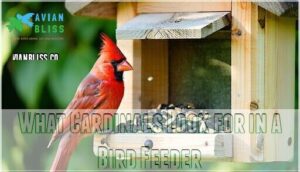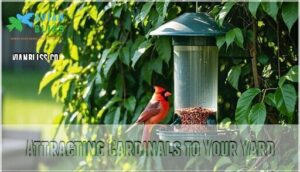This site is supported by our readers. We may earn a commission, at no cost to you, if you purchase through links.
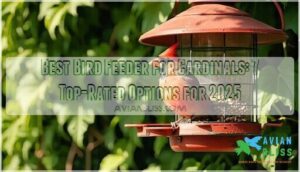
Cardinals prefer feeders like hopper or platform styles since these provide stability and easy access to their favorite seeds, like sunflower or safflower.
Consider squirrel-proof options to keep pesky intruders away and guarantee the feeder’s durability for outdoor conditions.
Bright colors, especially red, can attract cardinals to your yard, and placing the feeder near shrubs or trees creates a safe, inviting environment.
Keep reading for top-rated feeders that’ll make these stunning birds regular visitors!
Table Of Contents
- Key Takeaways
- Choosing The Best Bird Feeder for Cardinals
- What Cardinals Look for in a Bird Feeder
- Top 4 Best Bird Feeders for Cardinals
- Attracting Cardinals to Your Yard
- Frequently Asked Questions (FAQs)
- Which bird feeder attracts Cardinals?
- Do cardinals come to bird feeders?
- What is a good feeder for a northern cardinal?
- Do Cardinals like a copper bird feeder?
- Which Cardinal feeder is right for your yard?
- How do you keep a cardinal in a bird feeder?
- What kind of bird feeders do cardinals like best?
- What is the 5 7 9 rule for bird feeders?
- What is the best bird feed for cardinals and blue jays?
- How high should a bird feeder be for cardinals?
- Conclusion
Key Takeaways
- Look for hopper or platform feeders with wide perches that make it easy for cardinals to access their favorite seeds like sunflower or safflower.
- Choose squirrel-proof feeders with durable materials like metal or weather-resistant plastic to protect the seeds and ensure long-term use.
- Position the feeder 5-6 feet above the ground near shrubs or trees to give cardinals easy escape routes and a safe, inviting environment.
- Opt for bright red feeders to catch the eye of cardinals, as they’re naturally attracted to this color.
Choosing The Best Bird Feeder for Cardinals
You’ll need to take into account specific features like hopper capacity, perch size, and squirrel-proofing mechanisms when selecting the ideal cardinal feeder for your backyard habitat.
The best feeders for cardinals provide ample perching space and accommodate their preferred black oil sunflower seeds while keeping the food supply protected from weather and unwanted visitors.
Cardinals thrive on comfortable perches and sunflower seeds while enjoying a safe, weather-protected feeding station in your backyard.
Type of Bird Feeder
Cardinals, with their striking red plumage, thrive at specific feeder types.
Cardinals brighten backyards with their crimson elegance, favoring feeders that combine comfort, safety, and easy access to their favorite seeds.
Platform feeders and tray feeders offer the flat surface these birds prefer, providing ample space for their larger frames. Hopper feeders keep seed dry while offering comfortable perches.
Tube feeders work well when equipped with cardinal-friendly rings or extended perches. Mesh feeders filled with sunflower seeds attract cardinals naturally.
For best results, choose a feeder that allows cardinals to perch comfortably while protecting their favorite seeds. Consider a cardinal platform feeder for ideal feeding and to attract these birds with their striking red plumage and larger frames.
Size and Capacity
When choosing a cardinal bird feeder, size and capacity matter greatly for both birds and your maintenance routine.
The ideal feeder dimensions should accommodate a cardinal’s 7.5-9.25 inch size while providing comfortable perching space. Look for feeders with at least a 2-pound seed capacity, which strikes a balance between refilling frequency and keeping food fresh.
Many factors influence cardinal feeder selection. Large capacity feeders holding 5-12 pounds work well for busy areas, reducing food waste and maintenance time while ensuring your cardinal visitors never go hungry.
Material and Durability
When building your cardinal sanctuary, the material you choose directly impacts how long your feeder will last through seasons of use.
Materials that offer superior durability include:
- Metal mesh with zinc-plating for rust prevention and weather resistance
- Epoxy resin construction for chew-proofing against persistent squirrels
- Heavy-duty plastic that won’t crack under cardinals’ strong beaks
- Terra cotta saucers that provide natural, durable feeding platforms
Quality construction guarantees you won’t be replacing your feeder every spring when the cardinals return.
Perches and Feeding Ports
While durable materials lay the foundation for a good cardinal feeder, the design of perches and feeding ports determines whether birds will actually use it.
Cardinals need comfortable dining arrangements, just like you do at your favorite restaurant.
- Wide perch platforms (at least 4 inches) provide stable footing for these larger songbirds
- Port size matters – cardinal beaks require openings of 2+ inches in diameter
- Port angle should face forward, allowing natural feeding position
- Perch placement should accommodate the cardinal’s 7-9 inch body length
Cardinals won’t perform acrobatics for their meals. They prefer cardinal-friendly perches made of sturdy materials where they can sit comfortably while feeding. The drainage design around feeding ports keeps seeds dry and prevents mold growth.
When shopping for bird feeders cardinals love, look for models with multiple feeding stations to reduce competition and keep your feathered friends coming back.
Squirrel-Proofing and Protection
Now that you’ve chosen the right perches for cardinals, let’s tackle their biggest competition: squirrels.
Weight-activated mechanisms
Cage designs
For truly squirrel-proof feeders, look for weight-activated mechanisms that close when heavier creatures land. Squirrel-resistant models with metal construction outlast plastic versions, while strategic feeder placement (away from jumping points) creates an additional barrier.
Consider feeder placement strategies to further deter squirrels. Chew-proof materials like RoxResin provide lasting protection against determined squirrels.
What Cardinals Look for in a Bird Feeder
You’ll find that cardinals search for feeders with ample perching space and easy access to their favorite black oil sunflower seeds.
These vibrant birds prefer platform or hopper-style feeders that provide sturdy surfaces where they can comfortably sit while enjoying their meal.
Favorite Seeds and Foods
Everyone knows that cardinals have distinctive food preferences that keep them coming back to your feeder.
When stocking your cardinal bird food supply, consider these favorites:
- Black oil sunflower seeds – their absolute top choice
- Safflower seeds – squirrels tend to avoid these, making them perfect cardinal options
- Crushed peanuts – cardinals love these high-protein treats
- Blended foods like Wagner’s Cardinal Blend with 60% sunflower content
- Audubon Park Cardinal Blend – specially formulated for ground feeding habits
During winter months, supplement with high-energy suet to help these beautiful red visitors thrive in cold weather, and consider their love for black oil sunflower seeds.
Comfortable Perches and Platforms
Five key elements make perches and platforms comfortable for cardinals. These crimson visitors need sturdy resting spots while dining.
Cardinals prefer wide platform feeders with at least 4-6 inches of perch space that accommodates their 7.5-9.25 inch bodies. For ideal cardinal comfort, choose perches made of metal or UV-resistant plastic.
Platform feeders designed specifically for cardinals feature mesh screen bottoms for excellent drainage design, keeping seeds dry and fresh. Safflower seeds can also deter squirrels.
When selecting cardinal bird feeders, pay attention to perch placement—cardinals prefer facing forward while eating, not twisting awkwardly. Cardinal-friendly perches should be positioned to allow these ground feeders to maintain their natural feeding posture.
Safe and Secure Environment
Cardinals consistently seek environments that offer both safety and security from potential threats. Creating a predator-protected sanctuary will encourage these beautiful red visitors to frequent your yard.
To establish a squirrel-proof haven for cardinals:
- Position feeders 10-12 feet from dense shrubs, providing quick escape routes while maintaining visibility
- Install weather-resistant feeders with proper stability to withstand environmental challenges
- Choose feeders made from bird-safe materials that won’t harm beaks or feathers
- Mount squirrel-resistant feeders away from jumping points and high-traffic areas
Material safety and feeder stability aren’t just conveniences—they’re essential for maintaining ideal bird health in your backyard sanctuary.
Easy Access to Food and Water
After creating a safe haven for cardinals, you’ll want to make certain your feeder offers easy access to their favorite treats.
Wide openings
Low perch height
Multiple ports
Built-in water tray
Regular cleaning keeps your feeder safe, while weather protection maintains seed freshness. Cardinals prefer sunflower and safflower seeds in feeders they can easily access without struggle.
Attractive and Visible Feeders
Most cardinals are drawn to feeders that stand out in your yard.
The right feeder aesthetics can transform your backyard into a cardinal hotspot.
- Bright red feeders create maximum cardinal visibility, tapping into their natural attraction to this color
- Open design feeders with ample perching space allow cardinals to feel comfortable while feeding
- Strategic feeder placement near shrubs or trees provides security, letting cardinals retreat quickly if threatened
For best results, keep your cardinal bird feeder clean and filled with fresh sunflower seeds.
Top 4 Best Bird Feeders for Cardinals
You’ll find our top four cardinal feeders designed with specific features that accommodate these beautiful red birds’ feeding habits and physical needs.
These selected models offer ample perching space, hold cardinals’ preferred seeds like black oil sunflower, and feature sturdy construction that protects food from both weather and unwanted visitors.
1. Squirrel Resistant Bird Feeder
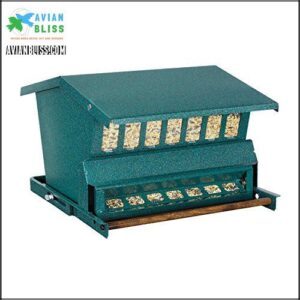
Reliability meets innovation in the Woodlink Squirrel Resistant Bird Feeder, a fortress designed specifically for cardinal enthusiasts.
The powder-coated steel body won’t rust or crack, standing up to years of outdoor use. You’ll love the ingenious weight-sensitive perch system that closes seed access when squirrels attempt to feed, while still welcoming cardinals and other small birds.
The generous 15-pound seed capacity means you’ll spend less time refilling and more time bird-watching. Its no-waste baffle prevents scattered seeds, saving you money and keeping your yard tidy.
This helps to guarantee bird feeder cleanliness, which is essential for avian health.
Installation couldn’t be simpler with versatile mounting options – hang it from a branch or use the included 5-foot pole.
The adjustable counter-balanced perch gives you control over which birds can access the feeder, effectively deterring larger nuisance birds like starlings and grackles.
Best For: Bird enthusiasts looking for a durable, squirrel-resistant feeder that supports cardinals and small birds while deterring squirrels and larger birds.
- Durable powder-coated steel body with a large 15-pound seed capacity.
- Weight-sensitive perch system effectively blocks squirrels and larger birds.
- Versatile mounting options and easy-to-clean design.
- Mounting pole may require reinforcement for better stability.
- Occasionally, seed may accumulate at the bottom and need manual adjustment.
- Single-sided feeder design limits viewing angles.
2. Woodlink Going Green Bird Feeder
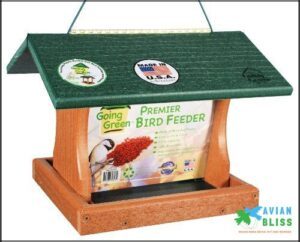
The Woodlink Going Green Bird Feeder stands as an environmentally conscious choice, crafted from up to 90% post-consumer recycled plastic.
You’ll appreciate its sturdy, screwed-together construction and powder-coated metal screen bottom that guarantees proper drainage.
The hinged roof makes filling and cleaning a breeze, while Plexiglas sides let you easily monitor seed levels.
With a capacity of 5.5 pounds, it accommodates multiple cardinals at once, and its durable design resists raccoon damage.
It includes a hanging cable for easy setup, and is made in the USA for reliable quality, with a focus on being eco-friendly.
Best For: Bird enthusiasts looking for a durable, eco-friendly bird feeder made from recycled materials.
- Hanging cord thickness may be a concern for some users.
- Requires regular seed replenishment to maintain usability.
- Design may not accommodate very large birds.
- Made from up to 90% post-consumer recycled plastic, promoting sustainability.
- Sturdy construction with a powder-coated metal screen for proper drainage.
- Easy to fill and clean with a hinged roof and clear Plexiglas sides.
3. Cedar Platform Bird Feeder 12×12

Why settle for less when the Cedar Platform Bird Feeder 12×12 delivers everything cardinals need?
This premium cedar feeder resists rot and insects while providing plenty of space for multiple birds to feed comfortably.
Its removable perforated seed tray allows for proper drainage and airflow, keeping seeds fresher longer.
Cardinals, jays, woodpeckers, and finches will flock to this sturdy platform design.
You’ll appreciate how easy it’s to clean and maintain with its removable tray.
The stainless steel screws guarantee durability, giving you years of birdwatching enjoyment right in your backyard, with a feeder that is easy to clean.
Best For: Backyard bird enthusiasts who want a durable, easy-to-clean feeder that attracts a variety of bird species, including cardinals and jays.
- Made from rot-resistant premium cedar for long-lasting use.
- Removable perforated tray keeps seeds fresh and simplifies cleaning.
- Designed to attract a wide variety of birds, including larger species like cardinals.
- May not deter squirrels or unwanted animals.
- Requires regular cleaning to maintain seed freshness.
- Open platform design might not protect seeds from rain in heavy storms.
4. Perky-Pet C00322 Red Cardinal Bird Feeder – 2.5 Feed Capacity

The Perky-Pet C00322 offers a distinctive dome design that keeps your cardinal visitors happy and protected.
This feeder holds 2.5 pounds of black oil sunflower seeds—a cardinal favorite—and features a clear plastic bowl that makes it easy to monitor seed levels.
The metal construction with zinc-plated finish resists rust and squirrel damage, though it isn’t completely squirrel-proof.
You’ll appreciate how the large overhang provides shelter for feeding birds, while cardinals might need time to warm up to it, the mesh surface allows them easy access to their meals.
Best For: Bird enthusiasts who want a durable feeder to attract and feed cardinals and medium-sized birds using black oil sunflower seeds.
- Not fully squirrel-proof, though resistant to damage.
- Cardinals may take time to adapt to using the feeder.
- Requires a container for easier filling due to design.
- Durable all-metal construction with rust-resistant zinc-plated finish.
- Large overhang provides shelter and shade for feeding birds.
- Collapsible design allows for easy storage when not in use.
Attracting Cardinals to Your Yard
You’ll attract America’s favorite songbird to your yard by strategically placing feeders in quiet areas with nearby shrubs for safety and quick retreats.
Cardinals prefer locations that offer both feeding access and protective cover, so position your feeder about 5-10 feet from trees or bushes for the best results, which will provide them with protective cover.
Ideal Feeder Placement and Location
Now that we’ve explored the best cardinal feeders, let’s focus on where to hang them.
The perfect feeder placement can make or break your cardinal-watching experience.
For ideal results, position your feeder 5-6 feet above ground near protective shrubs or evergreens.
This strategic placement offers cardinals quick escape routes from predators while still providing good visibility for your viewing pleasure.
Cardinals appreciate a balance between openness and safety.
Consider sunlight exposure when choosing your spot, but avoid areas near reflective windows that might cause bird collisions.
A location with some weather protection will keep both the birds and seeds dry during storms.
The cardinal habitat sweet spot combines proximity to cover with enough open space for these beautiful red birds to feel comfortable dining at your feeder.
Providing Fresh Water and Food
Now that you’ve chosen the perfect spot for your feeder, keeping cardinals well-fed and hydrated is your next priority.
Cardinals thrive when you provide:
- Black oil sunflower seeds and safflower seeds as their primary food sources
- Fresh water in a shallow birdbath located near your feeders
- Regular cleaning of both feeders and water sources to prevent disease
Change your cardinal seed mix seasonally—offering more fat-rich options during winter months.
Remember to replace water daily and break ice during freezes. A heated birdbath in winter will make your yard a cardinal hotspot while natural food sources are scarce.
Creating a Safe and Welcoming Environment
Cardinals love safety and comfort around their feeders. Keep predators out with barriers or baffles for Predator Protection.
Place the cardinal bird feeder near shrubs or evergreens to mimic their natural Habitat. Cardinals are more likely to use open-shelved designs over traditional enclosed birdhouses.
Here’s a handy table:
| Feature | Benefit |
|---|---|
| Weather Shielding | Food stays dry |
| Cardinal-friendly perches | Suits their size |
| Feeder Hygiene | Prevents illnesses |
| Space Considerations | Encourages feeding |
These steps make your yard ideal for attracting cardinals.
Offering Suet and Other Treats
When feeding cardinals, offering suet benefits them with extra energy, especially in colder months.
Use a suet feeder cardinals love and fill it with seasonal treats like sunflower hearts, safflower seeds, or cracked corn.
For added variety, mix safe ingredients such as dried mealworms, unsalted peanuts, or berries into homemade suet. Consider buying suet cakes designed specifically for cardinals.
High-protein treats guarantee they stay strong during breeding season. Keep feeders for cardinals accessible and full, attracting cardinals while keeping them happy and healthy year-round.
Planting Native Shrubs and Trees
To make your yard irresistible to Northern Cardinals, think beyond feeders.
Adding the right plants is a long-term investment in attracting cardinals. Native shrubs and trees offer food, shelter, and safety, creating a natural environment they crave.
- Native Shrub Selection: Dogwood, juniper, and holly provide year-round cover.
- Tree Planting Guide: Serviceberry and flowering dogwood add berries and vibrant blooms.
- Cardinal Habitat Creation: Layer shrubs and trees for nesting spots and escape routes.
Visit a local nursery for seasonal planting tips!
Frequently Asked Questions (FAQs)
Which bird feeder attracts Cardinals?
Picture a cozy diner for cardinals—platform feeders or hopper-style ones with flat surfaces and ample perching space suit them best.
Pick models offering black-oil sunflower seeds, durability, and squirrel resistance for a winning birdwatching experience.
Do cardinals come to bird feeders?
Yes, they do! Cardinals love well-designed bird feeders that provide space for perching and easy access to seeds like sunflower or safflower.
Place feeders in quiet spots to attract these territorial, vibrant songbirds.
What is a good feeder for a northern cardinal?
A sturdy platform or hopper feeder with ample space and perching spots works best for northern cardinals.
Opt for durable materials like powder-coated steel, and make certain it’s squirrel-proof to keep their favorite sunflower seeds safe.
Do Cardinals like a copper bird feeder?
A copper bird feeder can attract cardinals if it offers ample perching space and easy access to seeds like sunflower or safflower.
Cardinals prioritize comfort and seed access over material, making design the key factor.
Which Cardinal feeder is right for your yard?
Choose a feeder that fits your yard’s space and cardinal-friendly designs, like hopper or tray feeders.
Look for features like perching areas, squirrel resistance, and weather protection to keep food fresh and attract cardinals comfortably.
How do you keep a cardinal in a bird feeder?
Keeping cardinals around is like hosting a dinner party—offer their favorites.
Use a sturdy feeder with ample perching space, black-oil sunflower seeds, and squirrel-proof features.
Place it in a quiet, safe location.
What kind of bird feeders do cardinals like best?
Cardinals prefer feeders with large, flat surfaces for comfortable perching, like tray or hopper feeders.
Opt for designs that hold sunflower seeds, stay squirrel-proof, and have sheltered areas to protect seeds from rain or snow.
What is the 5 7 9 rule for bird feeders?
The 5-7-9 rule reminds you to place bird feeders at least 5 feet off the ground.
The rule also specifies that feeders should be 7 feet from predator cover like bushes, and 9 feet away from jumping points to protect birds and feeders.
What is the best bird feed for cardinals and blue jays?
Sunflower seeds support cardinals and blue jays superbly.
Both enjoy black-oil sunflower seeds, safflower seeds, and peanuts.
Offer a mix for variety, and watch as these vibrant birds flock to your feeder like neighborhood celebrities!
How high should a bird feeder be for cardinals?
Place the feeder 5 to 6 feet above the ground.
This height keeps cardinals safe from predators while making it easy for them to access.
Make certain nearby trees or shrubs offer shelter and landing spots.
Conclusion
Feeding cardinals isn’t rocket science, but they definitely have their preferences.
The best bird feeder for cardinals combines sturdiness, wide perches, and easy access to seeds like sunflower or safflower.
Pick squirrel-proof options to keep the seeds for the birds, not uninvited guests.
Place the feeder near shrubs or trees for safety, and consider a red design to catch their eye.
With the right setup, you’ll enjoy watching these vibrant birds visit your yard regularly.

